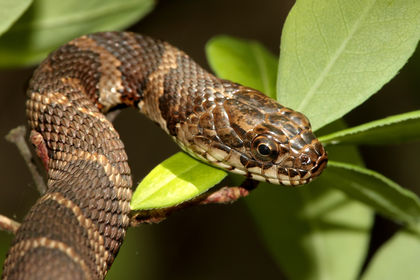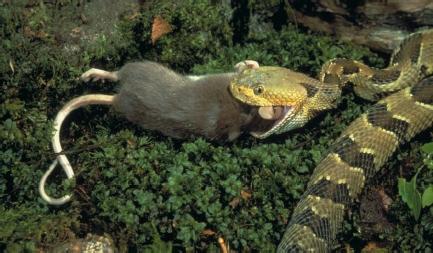Snakes

Snakes are limbless reptiles with long, cylindrical bodies, scaly skin, lidless eyes, and a forked tongue. Most species are not poisonous, some are mildly poisonous, and others produce a deadly poison. The term venom is commonly used to describe the poison produced by a snake.
All snakes are carnivores (meat-eaters) and cold blooded, meaning their body temperature is determined by the environment rather than being internally regulated. For this reason, snakes are found mainly in tropical and temperate regions, and are absent in cold climate zones.
Types of snakes
The 2,700 species of snakes fall into four superfamilies: Boidae (boas, anacondas, and pythons), Elapidae (cobras, coral snakes, mambas, and kraits), Colubridae (king snakes, water snakes, garter snakes, black snakes, and adders, to name only a few) and Viperidae (true vipers and pit vipers).
Members of the Boidae family are among the most primitive of all snakes. They are constrictors that kill their prey by squeezing it to death. Some of the largest snakes are members of this family. Some anacondas, for example, have been known to grow to more than 11 meters (37 feet) in length.
Snakes in the Elapidae family have grooved or hollow fangs in the front of the mouth. The bases of the fangs are connected to the venom gland. Venom is injected when the victim is bitten. Members of this family range in size from the tiny elapids, which may be no more than a few centimeters long, to the feared taipan, which may grow to nearly four meters (12 feet) in length.
The Colubridae family is huge, with more than 1,400 species, and includes the majority of living species. Most colubrids are harmless, but a few are extremely dangerous. Examples are the rear-fanged snakes, such as the African boomslang or the crown snake. These snakes do not release their poison through hollow fangs. Instead, they inject poison by chewing their prey after it is in their mouth.
Members of the Viperidae family are among the most dangerous of all snakes. They include in addition to the vipers themselves the rattlesnake, fer-de-lance, and bushmaster. Most members of the family have a wedge-shaped head that people have come to associate with poisonous snakes.
Anatomy and physiology
Snakes have extremely poor sight and hearing. They detect their prey primarily by means of vibrations, heat, and chemical signals they detect with their other senses. For example, a snake's flicking, forked tongue acts as a chemical collector, drawing chemical "smells" into the mouth. Those smells are then analyzed by two chemical sensors known as Jacobson's organs on the roof of its mouth. This mechanism also allows male snakes to detect females in the reproductive state.
Words to Know
Carnivore: A flesh-eating animal.
Jacobson's organs: Chemical sensors located on the roof of the mouth of a snake used to detect chemical "smells."
Molt: To shed an outer layer of skin at regular intervals.
Venom: A poison produced by a snake.
Another mechanism used by snakes to detect prey is a set of tiny pits or hollows that certain kinds of vipers have on the side or top of their heads. These pits can detect the body heat of prey at considerable distances.
Contrary to popular belief, snakes are not slimy. The scales that cover their bodies are dry but glistening, giving a sheen that offers an appearance of wetness. Scales protect the snake's body from friction and dehydration. They also aid its movement by gripping the surface while powerful muscles propel the body forward, usually with a horizontal waving motion. This method of movement means that snakes cannot move backward.
Instead of eyelids, the eyes of snakes are covered and protected by clear scales. Several times a year, snakes molt, shedding their skin in one complete piece by rubbing against a rough surface.
Snakes' teeth do not allow them to chew and break up the bodies of their prey. Instead, they usually swallow their prey whole. Special ligaments in the snake's hinged jaw permit its mouth to open to as much as a 150-degree angle. Thus, the snake can swallow animals many times larger than the size of its own head. The largest recorded feast was a 130-pound (59-kilogram) antelope swallowed by an African rock python.
Snakes' teeth face inward and prevent the prey from escaping. The snake's strong jaw and throat muscles work the food down the esophagus and into the stomach, where digestion begins. Digestion time differs, and is influenced by temperature. In one instance, a captive python at a room temperature of 30°C (87°F) digested a rabbit in four days. At cooler temperatures (18°C; 64°F), however, digestion took more than two weeks.

The interval between meals also varies. Some snakes go weeks or even months without food. In temperate climates, snakes may fast and hibernate during the winter months. Pregnant females may hibernate and fast seven months, while both sexes fast before shedding.
Hunting and defense
The coloring of a snake's skin scales provides an excellent camouflage from predators and prey. Tree snakes can have a color as green as any leaf in the forest; ground snakes are as brown or dusty grey as the earth and rocks; and sea snakes are dark above and light beneath. Some snakes are brightly colored with vivid patterns that warn potential predators to stay away. An example is the highly venomous coral snake, which has orange, black, and white rings.
Snakes attack only when hungry or threatened. When frightened, they tend to flee. If there is no time for flight, or if snakes are cornered or antagonized, they strike. Venomous snakes have two fangs in the upper jaw that penetrate the flesh of their prey. Poison glands then pump venom through grooves inside the fangs into the prey. Some species of snake inject their prey with toxin and wait until the animal is no longer capable of struggling before eating it. Snake venom is purely a feeding aid, serving both to subdue the prey and to aid in its digestion before it is swallowed.
Nonvenomous constrictors, such as boas, pythons, and anacondas, first snatch their prey in their jaws. Then, with lightning speed, they coil their bodies around the animal, squeezing its thorax to prevent breathing. Amazingly, the prey's bones remain unbroken during this process.
Snakes and humans
Snakes have fascinated and frightened humans for thousands of years. Some cultures still worship snakes, seeing them as creators and protectors. Other cultures fear snakes as devils and symbols of death.
In many ways, snakes serve a valuable function for human societies. They prey on animals, such as rats and mice, that we often regard as pests. Many people enjoy keeping snakes as pets also.
On the other hand, many people have a terrible fear of these reptiles. They may believe that the only good snake is a dead snake. Unfortunately, this attitude leads to the death of many harmless snakes. Yet, as much as most humans fear snakes, snakes fear humans more. Certainly, some snakes can kill a human in a matter of minutes, and no snake should be handled unless positively identified as harmless. However, the estimated risk of venomous snakebites to humans in the United States is 20 times less than being struck by lightning. Overall, a well-educated, healthy respect for snakes would benefit both humans and snakes.
[ See also Reptiles ]